Thecus N2560: Intel's EvanSport NAS Platform Review
by Ganesh T S on November 25, 2013 3:30 PM ESTCIFS Performance Evaluation
Evaluating the N2560 was fairly straightforward. We only needed to check up on CIFS performance (as both NFS and iSCSI are not supported). The unit was configured with two WD4000FYYZ (WD RE) 4 TB drives in RAID-1 configuration. From the outside, it looks like it would be ideal to compare the performance of this unit with that of the ReadyNAS 312 we reviewed a couple of weeks back. Unfortunately, the presence of two GbE ports on the RN312, as well as business targeted feature set puts it in a different class. As such, we can compare with other ARM-based 2-bay units. The Synology DS213 is one such unit that we have evaluated before in the form of the ioSafe N2.
Single Client (Windows) Mode:
The single client CIFS performance of the Thecus N2560 was evaluated on the Windows platforms using Intel NASPT and our standard robocopy benchmark. This was run from one of the virtual machines in our NAS testbed. All data for the robocopy benchmark on the client side was put in a RAM disk (created using OSFMount) to ensure that the client's storage system shortcomings wouldn't affect the benchmark results
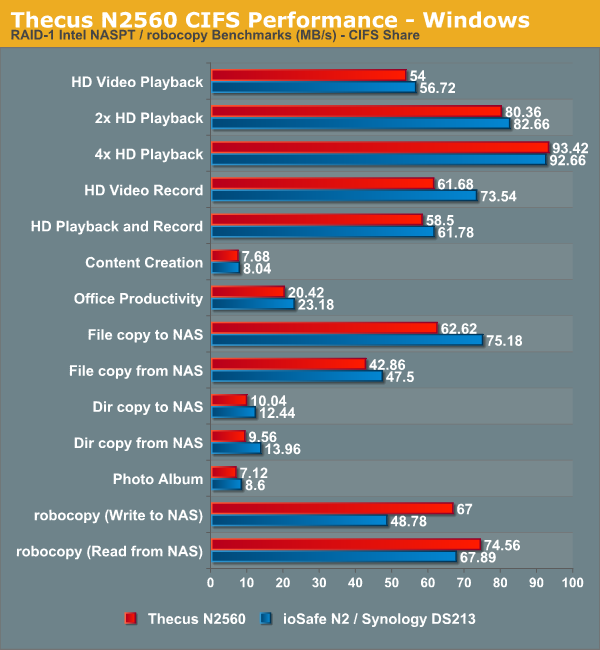
We find that the ARM-based ioSafe N2 / Synology DS213 performs better than the Thecus N2560 in a majority of the tests. However, the robocopy benchmarks (more representative of home users copying lots of files to and from the NAS) land in favour of the Thecus N2560. I would say that, based on performance alone, the Thecus N2560 will run neck-and-neck with the modern ARM-baed 2-bay units such as the Synology DS213.
Multi-Client (Windows) Mode:
We put the Thecus N2560 through some IOMeter tests with a CIFS share being accessed from up to 25 VMs simultaneously. The following four graphs show the total available bandwidth and the average response time while being subject to different types of workloads through IOMeter. IOMeter also reports various other metrics of interest such as maximum response time, read and write IOPS, separate read and write bandwidth figures etc.. Readers interested in the actual values can refer to our evaluation metrics table available here.
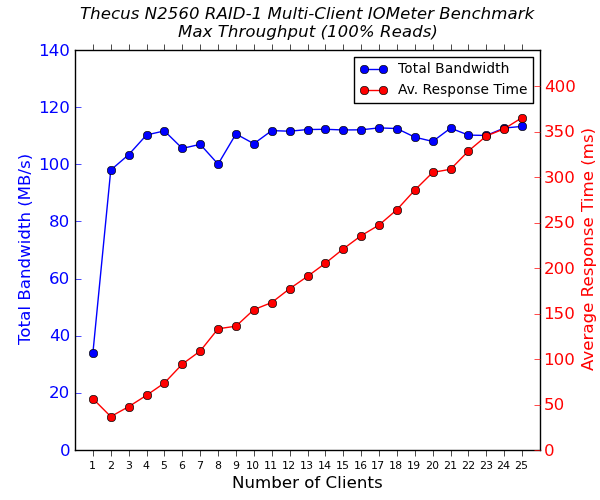
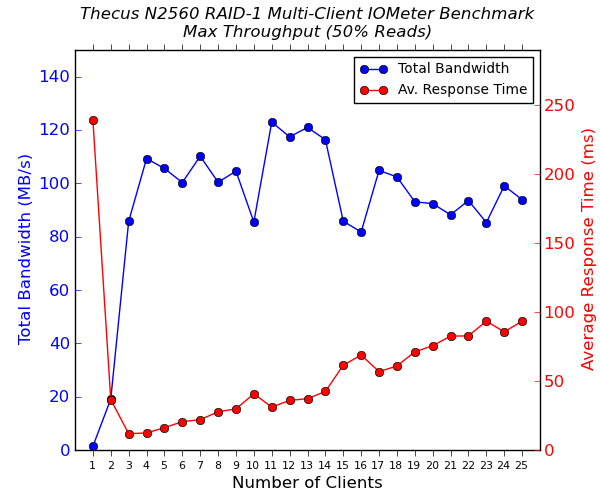
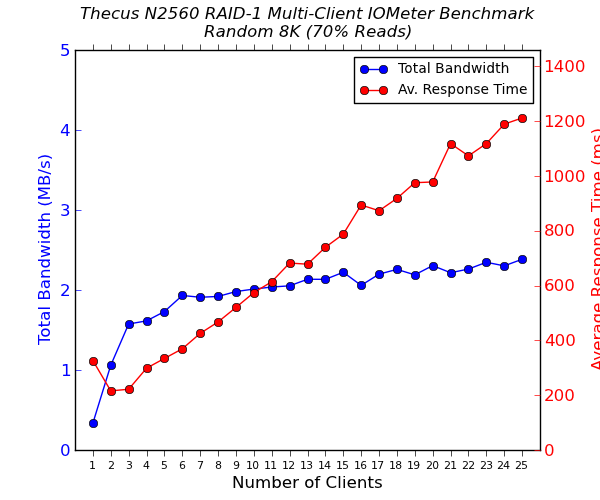
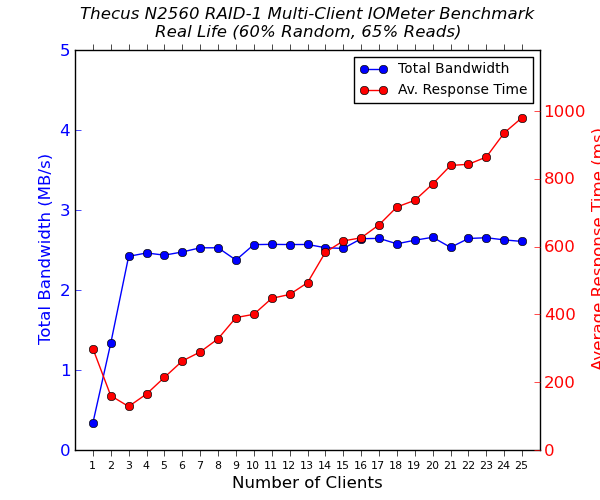
Comparing these graphs with what we obtained for the ioSafe N2 / Synology DS213, it can be inferred that the Thecus N2560 manages to maintain performance even as the number of clients connected to it keeps increasing. For the Synology DS213, we saw a dip in performance after more than 10 clients started connecting to it. The Thecus N2560 also manages to get consistently better average response times in various tests (for the same number of clients). However, it is not clear whether the average home consumer will have more than 10 clients simultaneously accessing data on the NAS. In that case, the choice may come down to non-performance aspects.










73 Comments
View All Comments
zach1 - Saturday, November 30, 2013 - link
So do you, at anandtech, have something against the nexus 5 or something?Xajel - Sunday, December 1, 2013 - link
@AnandTech, I would love to see a roundup review for Home NAS, 2 & 4 bays... most NAS makers actually target Small offices rather than homes, making the NAS expensive and not friendly enough for the home user... I believe the market for Home only NAS is big but they need to know how to make it works and function... most home users want it for backup, storage and media streaming... no need for these advanced networking things required by business and small offices...eek2121 - Sunday, December 1, 2013 - link
I will never buy another Thecus product, after their lack of support for their W12000 product left us high and dry. Support was so bad, we even got the certain (major) vendor we purchased it from to give us a $100 gift card and cease carrying the product altogether. They shipped the remaining units back to Thecus and immediately discontinued selling the product.eek2121 - Sunday, December 1, 2013 - link
btw...I just want to add, don't buy Thecus's windows storage server solutions. I'll give you a hint: It does not come with a Windows Storage Server license (regardless of what various companies like newegg, etc. claim) and you cannot buy one from Thecus. Where does that leave you? OSless.azazel1024 - Monday, December 2, 2013 - link
Interestingly my server at home, which is based around a G1610 Celeron, mATX board, 8GB of 1.25v DDR3 1600 and a pair of Intel GbE CT NICs, a 60GB SATAIII SSD for the boot/app drive and a pair of Samsung F4EG 2TB drives in RAID0 idles only slightly higer than the Thecus NAS does and actually STREAMS at lower power consumption (by 1W, but still lower).A heck of a lot more capable...pretty much the same price when all was said and done for the hardware.
It'll saturate both GbE links (running Windows 8, so SMB3.0 loveliness) for 240MB/sec reads/writes.
Back-up is my desktop, which has all of the data mirrored (but of course isn't on all the time and also is a much higher spec machine).
NAS are interesting, but I just don't see the place for them except
A) Needing a set spec machine
B) Not wanting/needing/able to build and roll your own server
C) going for a lower end 1 or 2 bay unit
Looking at the price of a 4 bay unit, my server suddenly goes from price parity to much cheaper, and I have room for 2 more disks in my server than what a 4 bay machine has. More than that if I don't mind a cheap RAID card, which doesn't add much cost.
You do have to deal with "managing" a "real" computer then and it doesn't build itself, but the cost is much lower and until you get to a very high end NAS (costing MUCH more), it generally isn't as capable in terms of overall through-put, number of users, etc. At that, a slight increase in price on the "server" hardware would easily get a core i3 or i5 to increase that capability substantially, low hot data on the SSD(s), etc.
Again, unless you are looking at limited IT support ability (personally or for your company) or going for a very budget NAS, I don't see the point. They are more limited and they tend to cost more (sometimes substantially). For the right build, they also don't tend to save much power (mine idles at 19w and active runs at 31w. With the proper 80+ Gold or Platnium PSU, it would likely idle more like 14-15w and active run around 28 or so).
no_nonsense4857 - Monday, December 2, 2013 - link
For a person using an external HDD and robocopy to perform scheduled synchs isn't a 2bay NAS a good value for money option in addition to the streaming capabilites and also RAID 1 option.I never knew what NAS is until a year back.
I am looking for a backup solution which has redundancy and can be scheduled. All other additional features are perks for which i do not care much and would be happy if they are taken off and the product is discounted.
azazel1024 - Tuesday, December 3, 2013 - link
It depends. If it is a real budget 2-bay, yes. However the one reviewed isn't particularly low cost (at least in my opinion).15 minutes of time with synchtoy and task scheduler and all my back-ups are scheduled for my desktop to my file server.
It probably isn't quite as straight forward as some of the NAS OSs are for things like scheduled back-up if you are a very novice user of Windows or other OSs, but it is not an advance process at all for setting up a basic windows server and setting up scheduled back-ups.
If you really don't need much, then your best bet is going for pretty much the lowest price NAS you can, that has at least some hardware reliability. If you want anything more than that, you are probably best off building your own, unless you are generally just a basic computer user and it would be beyond your capabilities.
azazel1024 - Tuesday, December 3, 2013 - link
Ganesh, for the mobile data access...why would you be missing that? On my home network I can access anything over Wifi with any of my SMB clients. On the road, if I cared to (I have set it up before, but it isn't currently setup) I can setup my server with Webdav and do port forwarding from my router and hit it with the same iOS client I use to access my data on my home wifi network (iOS File Browser. Awesome and cheap app).I fail to see any thing at all that this NAS can do that my server can't. My server is also a lot more capable, for example I have it running my Calibre server, which I haven't seen any NAS which has the functionality built in, so I can access my library anywhere. I can do other webserving off it if I want to. It does all my back-ups and I even RDP in to it on occasion when I want to run something a lot faster while using low spec hardware (admittedly, when I usually want to do that, I'll wake my desktop and RDP in to that).
If there happens to be something on my desktop, say I just transcoded a large video, and I want to get it on the server to access it from something else, again, like a large movie, it takes just a few seconds over the dual GbE link. Half the time, or probably less, than it would to almost any dual bay NAS, or most any NAS (are any NAS OSs currently running SMB3.0 and capable of SMB multichannel? I am not aware of any, yet).
If I want higher bandwidth to the server, I can link aggregate my two Intel GbE NICs AND re-enable the realtek GbE onboard NIC and connect it up to the switch for 2Gbps of max speed to my desktop and 3Gbps of total through-put to the server. Though the disk array isn't capable of saturating that. I could setup part of the SSD in caching mode though and in that case, the smaller frequently accessed files (which wouldn't be much since it is generally the big files that are being accessed on the server) could easily saturate all links. With the native Windows SMB/disk caching, the disk array probably could handle 3Gbps writes for a period of time though (perks of 8GB of RAM in the machine).
I get the use case for A) a user who doesn't have the spare time to roll their own B) A user who is a novice computer user/one who has set computer use cases and doesn't deviate so wouldn't technically be able to setup any of it C) Needs to roll multiple instances of the same hardware and OS and want it to be more or less identical for support reasons
Outside of those three, it is generally not cheaper or as capable as rolling your own file server. At least in the instance of the reviewed NAS or other higher end 2-bay NAS. If you don't need the capabilities of a higher end NAS AND you go with a lower end 2-bay NAS because of this, then that is probably a better bet as you aren't paying for features you don't need and probably would be at least slightly cheaper than rolling your own inexpensive server.
azazel1024 - Tuesday, December 3, 2013 - link
Ganesh, for the mobile data access...why would you be missing that? On my home network I can access anything over Wifi with any of my SMB clients. On the road, if I cared to (I have set it up before, but it isn't currently setup) I can setup my server with Webdav and do port forwarding from my router and hit it with the same iOS client I use to access my data on my home wifi network (iOS File Browser. Awesome and cheap app).I fail to see any thing at all that this NAS can do that my server can't. My server is also a lot more capable, for example I have it running my Calibre server, which I haven't seen any NAS which has the functionality built in, so I can access my library anywhere. I can do other webserving off it if I want to. It does all my back-ups and I even RDP in to it on occasion when I want to run something a lot faster while using low spec hardware (admittedly, when I usually want to do that, I'll wake my desktop and RDP in to that).
If there happens to be something on my desktop, say I just transcoded a large video, and I want to get it on the server to access it from something else, again, like a large movie, it takes just a few seconds over the dual GbE link. Half the time, or probably less, than it would to almost any dual bay NAS, or most any NAS (are any NAS OSs currently running SMB3.0 and capable of SMB multichannel? I am not aware of any, yet).
If I want higher bandwidth to the server, I can link aggregate my two Intel GbE NICs AND re-enable the realtek GbE onboard NIC and connect it up to the switch for 2Gbps of max speed to my desktop and 3Gbps of total through-put to the server. Though the disk array isn't capable of saturating that. I could setup part of the SSD in caching mode though and in that case, the smaller frequently accessed files (which wouldn't be much since it is generally the big files that are being accessed on the server) could easily saturate all links. With the native Windows SMB/disk caching, the disk array probably could handle 3Gbps writes for a period of time though (perks of 8GB of RAM in the machine).
I get the use case for A) a user who doesn't have the spare time to roll their own B) A user who is a novice computer user/one who has set computer use cases and doesn't deviate so wouldn't technically be able to setup any of it C) Needs to roll multiple instances of the same hardware and OS and want it to be more or less identical for support reasons
Outside of those three, it is generally not cheaper or as capable as rolling your own file server. At least in the instance of the reviewed NAS or other higher end 2-bay NAS. If you don't need the capabilities of a higher end NAS AND you go with a lower end 2-bay NAS because of this, then that is probably a better bet as you aren't paying for features you don't need and probably would be at least slightly cheaper than rolling your own inexpensive server.
SerinaxD - Wednesday, December 4, 2013 - link
this looks incredible~